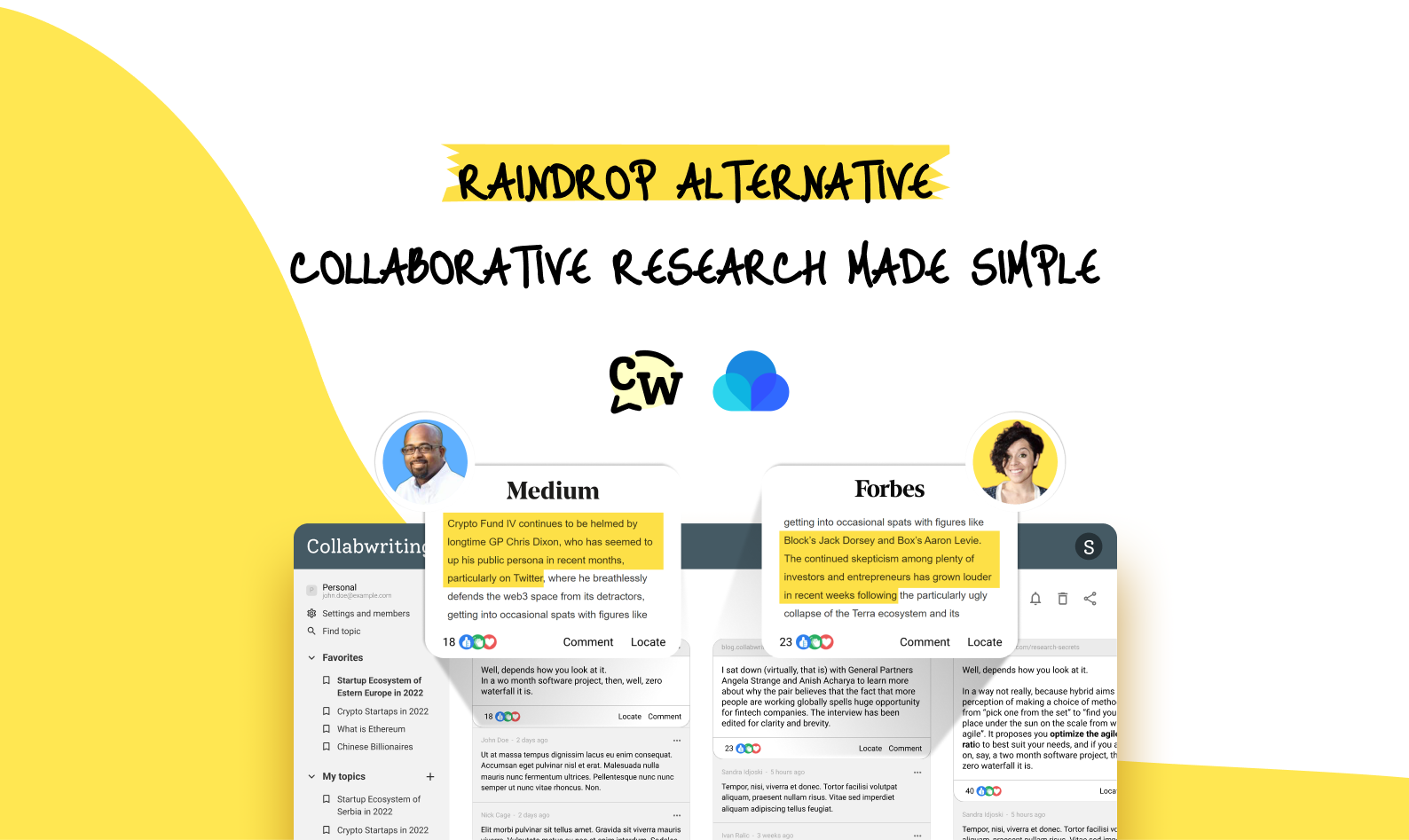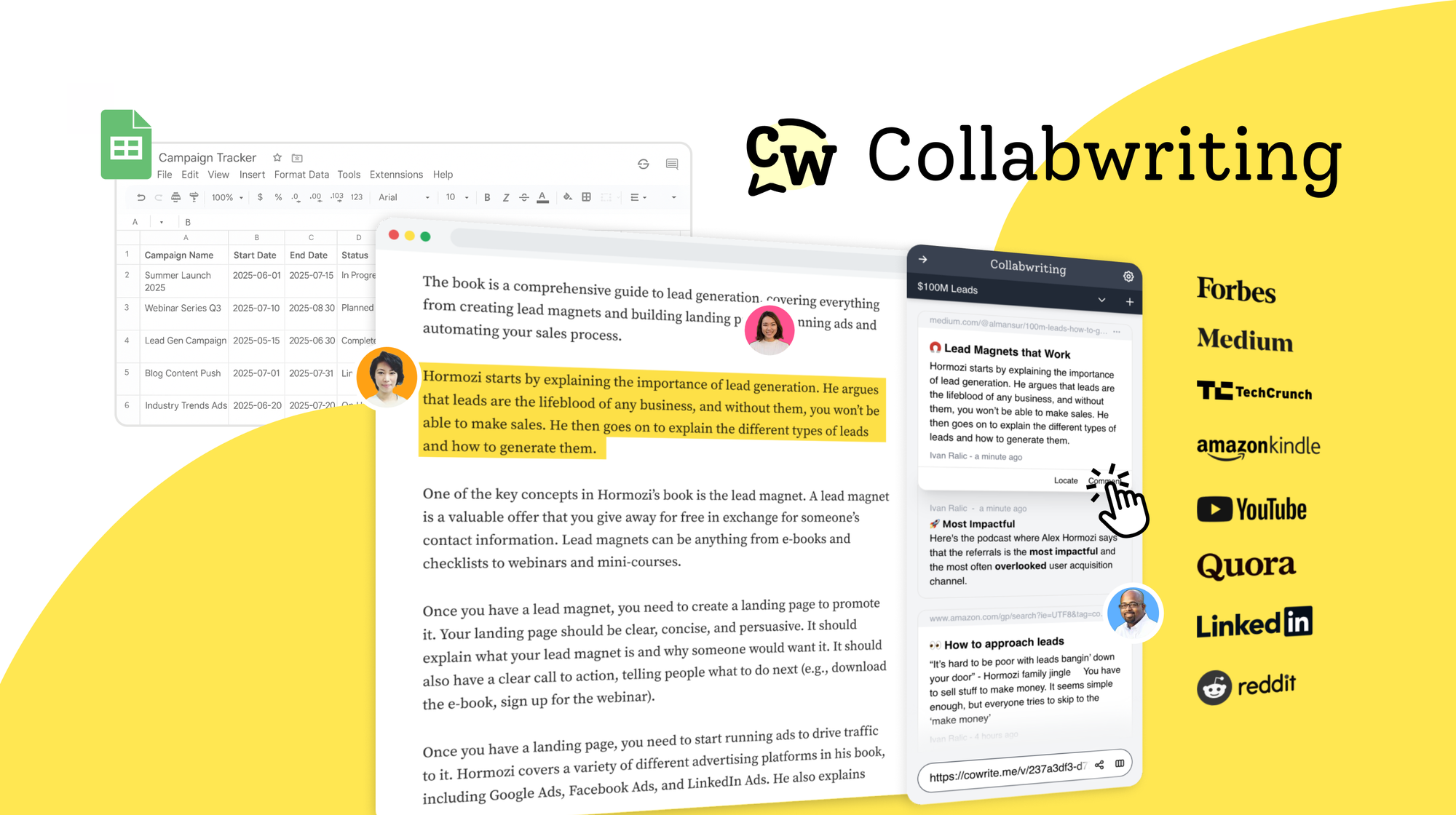What is the meaning of knowledge?
Let's start with the definition of knowledge.
Knowledge refers to information, understanding, or skills gained through experience, education, or training. It involves awareness and familiarity with facts, truths, concepts, or skills that are acquired and retained by an individual.
If we dig deeper, we can categorize knowledge into seven types.
To discover more, keep reading! ⬇️
What is knowledge management?
Knowledge management is the process a company uses to gather, organize, share, and analyze its knowledge so that it's easily accessible to employees.
This can include information such as marketing campaign strategies, legal compliance guidelines, consulting procedures, industry insights, client case studies, and internal project management techniques.
Knowledge management includes using data mining and tools to make information easily accessible
to users.
A good knowledge management plan starts with understanding what the company needs and picking the right tools to meet those needs.
The main challenge is choosing or creating a system that fits the company’s goals and encourages employees to use it and share knowledge.
Companies with a knowledge management strategy achieve their goals faster. Better learning and teamwork speed up decision-making, and streamlined processes like training and onboarding lead to happier, longer-lasting employees.
Key stages in the knowledge management process
While creating and sharing knowledge is important, knowledge management shouldn’t end there. It also involves organizing, using, and retaining this knowledge effectively.
Ensuring these steps are part of the process helps maintain a valuable and dynamic knowledge base.
- Knowledge creation: Developing new ideas and insights through research and experience
- Knowledge capture: Collecting and documenting useful information from various sources
- Knowledge organization: Structuring and sorting information so it’s easy to find and use
- Knowledge sharing: Making the information available to everyone who needs it, through training or knowledge bases
- Knowledge utilization: Applying the knowledge to improve decision-making and solve problems
- Knowledge review: Regularly checking and updating the information to keep it accurate and relevant
- Knowledge retention: Ensuring important knowledge is preserved, even when employees leave the company
Research conducted in 2023 found that 47% of employees don't know where to find the information they need or don’t have permission to access it. This problem is often due to poor knowledge management and outdated technology.
7 types of knowledge management
Explicit knowledge
Explicit knowledge, also called expressible knowledge, refers to information that can be written down, stored, and shared. It can be easily shared with customers or employees within an organization.
This knowledge is a helpful resource for others and can be documented in different ways, like knowledge bases, manuals, books, or videos.
Implicit knowledge
Implicit knowledge is putting explicit knowledge into practice such as reading a guide on effective social media marketing strategies and then implementing those strategies in your company's social media campaigns.
Tacit knowledge
Tacit knowledge is the kind of knowledge we gain through personal experience and situations. It's what we know but find challenging to express or put into words.
For instance, a marketer’s instinct for selecting the right tone and message for a campaign often comes from years of experience rather than formal rules.
Declarative knowledge
Declarative knowledge includes clear, factual information, like basic principles and concepts. When new employees join, it’s important to teach them these basics about the company and their job roles during onboarding. Experienced employees should already know this information.
Examples include training guides for new hires and introductory content for new readers.
Procedural knowledge
Procedural knowledge is about knowing how to perform tasks, gained through hands-on practice. It’s different from factual knowledge because it focuses on how to do things rather than what they are.
To prevent losing this important information when employees leave, it should be documented. Examples include training sessions, interactive demos, and step-by-step process guides.
Next comes two more opposite knowledge concepts: a priori knowledge and a posteriori knowledge.
A prirori knowledge
A priori knowledge comes from logical thinking rather than personal experience. It’s used in fields like math and philosophy.
For example, executives might use this type of knowledge to determine that the company needs a specific number of sales each month to break even and make a profit.
Although it’s less common in everyday business, it’s important for strategic planning and decision-making.
A posteriori knowledge
A posteriori knowledge is gained from experience and observation. Unlike a priori knowledge, which comes from logic alone, a posteriori knowledge relies on what you’ve seen and done.
This type of knowledge is useful for creative problem-solving and finding new opportunities. For example, teams might come up with better ways to improve processes based on their hands-on experiences.
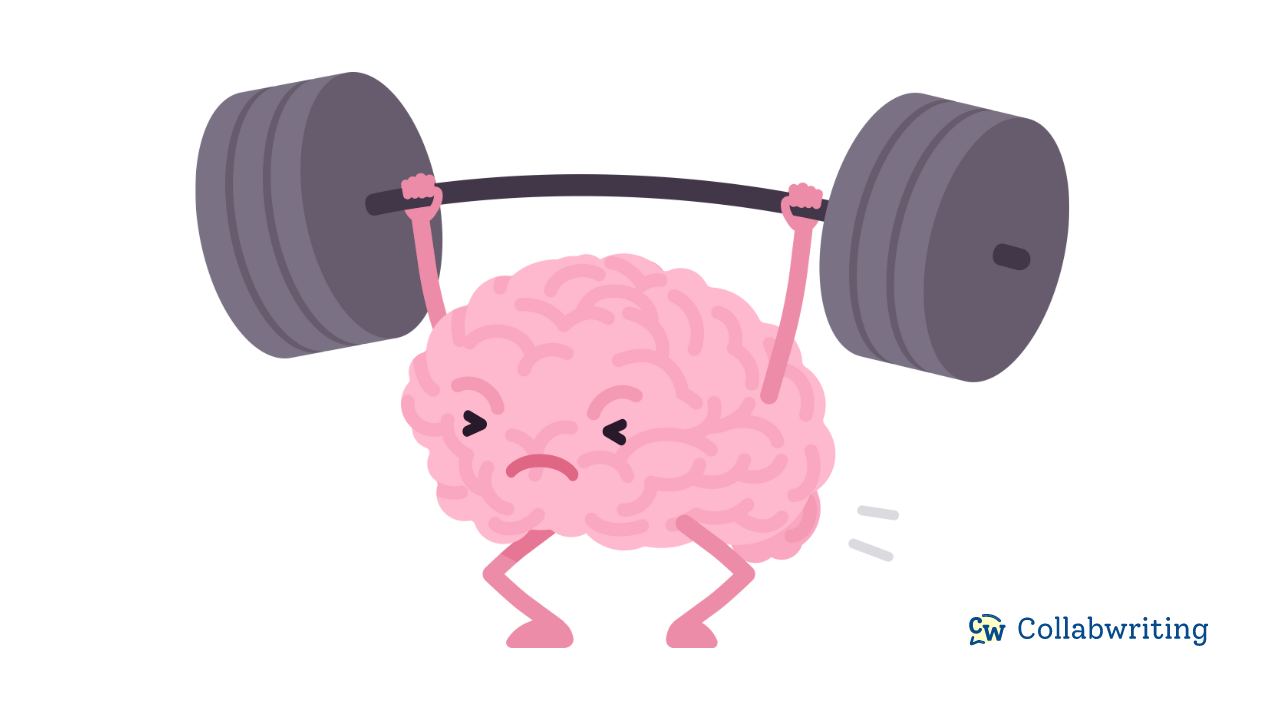
Frequent knowledge management pitfalls
No clear plan: Without a clear strategy for managing knowledge, it's hard to know what information to collect and how to use it effectively.
Poor documentation: If important information isn't well-documented, it can be lost or hard to find when needed.
Limited sharing: Not promoting knowledge sharing between employees means valuable insights and expertise might stay isolated rather than benefiting the whole team.
Outdated information: If knowledge isn’t regularly updated, it can become irrelevant or inaccurate, reducing its usefulness.
Ignoring user needs: If you don’t consider how users will interact with the knowledge, it can become difficult for them to find and use it effectively.
Not retaining key knowledge: Without a plan to keep essential knowledge when employees leave, you risk losing valuable information that could impact the organization.
Not investing in resources: Failing to invest in resources for continuously building and maintaining knowledge management content can lead to outdated systems and missed opportunities for improvement.
Benefits of implementing a knowledge management cycle
Putting a knowledge management cycle into action brings a bunch of good stuff. It helps you make smart choices, avoid doing the same thing over and over, and make the workplace a learning-friendly spot.
When everyone can easily get and use the knowledge they need, the whole team works better and gets things done faster.
A strong knowledge management cycle helps the organization stay creative and open to new ideas. It promotes teamwork and encourages trying out new approaches. By learning from what works and continuously improving, the organization can adapt and thrive in its industry.
Here are the key benefits:
- Improves collaboration: Team members can easily share and access information, improving teamwork and communication across the organization.
- Streamlines customer onboarding: Knowledge management tools help customers get the most out of your product or service, especially during their initial setup.
- Improves employee training and onboarding: New team members can access the knowledge base to get the information they need without depending on specific colleagues.
- Increases efficiency: Knowledge management helps streamline processes and reduce repetitive tasks, so work gets done faster and more smoothly.
- Fosters innovation and growth: By continually sharing and building on knowledge, your business can come up with new ideas and adapt more quickly to changes.
- Cost savings: By cutting down on duplicated efforts and improving how resources are used, knowledge management helps make your business more cost-efficient.
The benefits you get from knowledge management will depend on how effectively you set up and run your system.
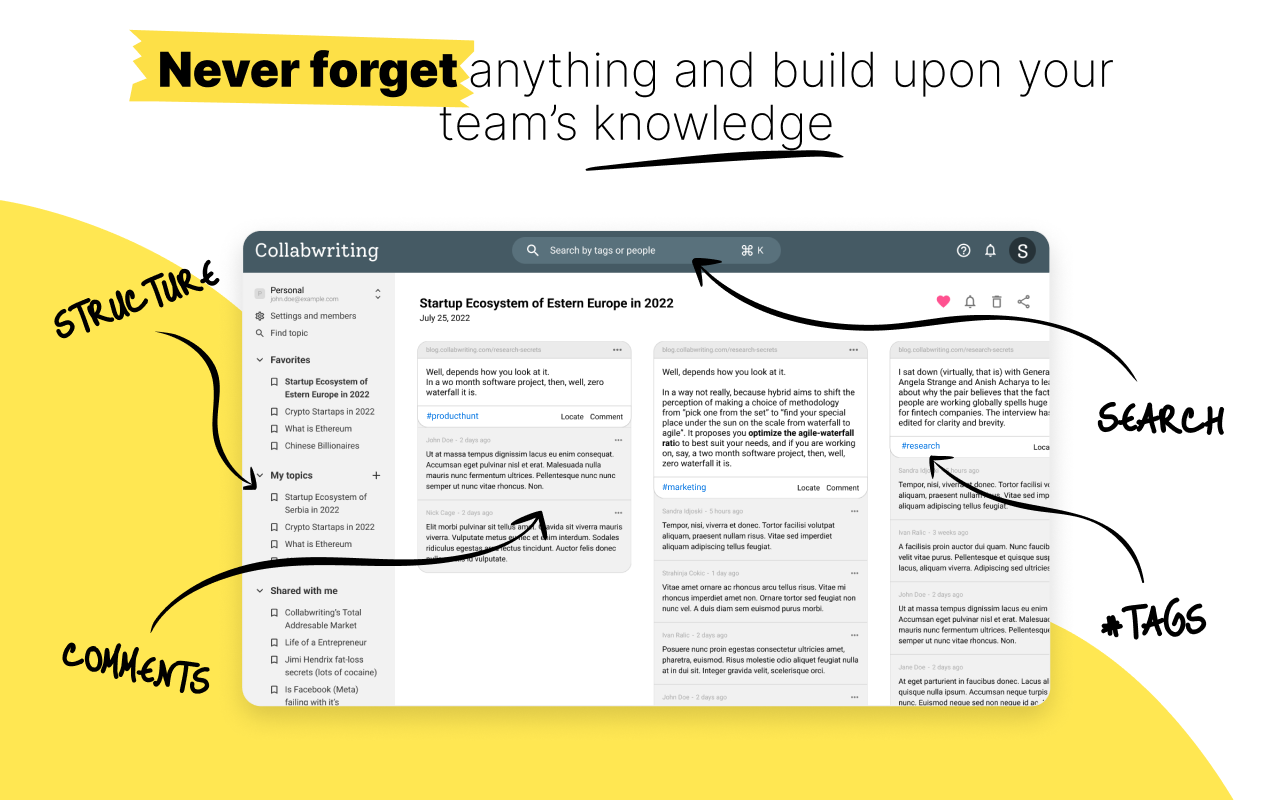
Collabwriting - Shareable Notes on Web Pages
Collabwriting allows you to gather all your online sources in one place to build a knowledge base. Just highlight, save, and collaborate with anyone on any content you find online.
Key components of knowledge management
Before diving deeper into Knowledge Management, you need to define your KM vision. The vision should align with your overall strategy and clearly show where you want KM to take you.
Next, outline what your KM strategy will include and exclude, so everyone knows what to expect. Starting with clear KM principles or guidelines will help your team stay on the same page.
What: The scope specifies what you want to accomplish.
How: The principles outline the steps and rules to achieve those goals.
To create a successful KM strategy, start by understanding your current situation. Then, imagine your ideal future state and plan the steps needed to get there for each key component.
Content
Content is often the most time-consuming part of your Knowledge Management strategy, but it's also the most important.
You’ve likely heard the phrase Content is King, and it’s absolutely true, even when it comes to Knowledge Management.
Here’s what you need to do:
- Identify, analyze, and prioritize: Start by identifying the content you need, analyzing its value, and prioritizing what’s most important
- Set standards: Define and agree on the standards for creating and managing content
- Define taxonomy: Establish a clear taxonomy or structure for organizing content
- Create and curate: Develop and manage content in a way that meets the needs of users and customers, and keep it updated and relevant over time
People
When you’re starting a Knowledge Management system, you’ll need two key groups of people:
- Senior leaders: These are business leaders who can champion the KM program and align it with the organization’s overall strategy. They should be actively involved and have a lot to gain from KM, especially if they’re facing urgent knowledge gaps (like retiring experts or new hires needing quick onboarding).
- Cross-functional stakeholders: These are colleagues from different departments who will help guide the KM program’s implementation.
Together, these groups will help ensure your KM program is set up for success.
Here are some examples:
- Marketing and Copywriting Teams: They create and manage content that supports knowledge sharing and branding
- Legal Advisors and Compliance Officers: They ensure that knowledge management practices comply with legal and regulatory requirements
- Consultants and External Experts: They provide specialized knowledge and advice for implementing and optimizing KM systems
- IT Specialists and Systems Administrators: They manage the technical infrastructure and troubleshoot issues related to KM tools and systems
- Business Analysts and Process Improvement Specialists: They analyze and refine business processes to ensure that KM practices are efficient and effective
- Product Managers and Development Teams: They contribute to and utilize KM resources to enhance product development and management
- Customer Support Representatives: They use KM tools to resolve customer issues and improve service delivery
- Training Coordinators and Learning & Development Teams: They integrate KM resources into training programs to ensure employees can access and utilize knowledge effectively
It's also important to review the current organizational structure for these stakeholders and identify areas where alignment with the KM strategy can be improved.
Technology
Knowledge Management isn’t just about IT or technology. Instead, technology is there to support and improve other KM efforts.
It’s crucial to first identify what you need from technology to meet your KM goals. Look at what tools and systems you already have to help users access, create, and manage knowledge.
Get input from your technical team to make sure the KM strategy fits with your plans. If needed, talk to current or new vendors about how their solutions can meet your requirements.
Staying updated is also key, so attending industry events and participating in KM forums can help you keep current with new trends and tools.
Processes
Analyze your current processes to see what's effective and what needs improvement.
It’s often more efficient to integrate KM practices into existing workflows rather than starting from scratch.
- How is content managed from start to finish?
- Where does new content come from?
- How is content collected and stored?
- How is content reviewed and approved?
- How is content shared with users?
- Is there a way for users to give feedback on the content?
- How are users trained to use the knowledge effectively?
- How do users find out about new or updated content?
- How is knowledge distributed and shared across the team?
- What process is in place to update, improve, or remove outdated content?
- What activities keep users engaged and adopting the KM system?
- How is the KM team trained and supported in their roles?
- How do you introduce new team members to the KM culture?
- How do you measure the effectiveness of your knowledge management practices?
- What tools and resources are available to support knowledge management efforts?
Governance
Governance ensures your Knowledge Management strategy stays on track and delivers as planned.
To make sure your KM strategy is on track, set up a steering committee with key stakeholders to make important decisions and ensure the strategy is delivering value. Keep senior stakeholders regularly involved to maintain their support.
You might also create a KM center of excellence in your organization to share best practices and stay current with the latest trends in content, technology, and business processes.
Metrics and benefits
Tracking metrics and benefits is crucial to show how well your KM strategy is working.
Define the key metrics you'll use to measure success, including both initial benefits and ongoing performance. This will help you stay aligned with your KM goals and demonstrate the value of your KM efforts.
Culture
Culture is a bit less tangible but just as important.
Assess your current culture to see if people are motivated to share knowledge and participate in knowledge sharing. Check if employees feel comfortable giving feedback and challenging ideas. Look for any issues with knowledge hoarding among experienced staff.
Ideally, you want to create a culture where everyone actively shares and manages knowledge. This way, everyone is involved and engaged in making knowledge sharing a part of daily work.
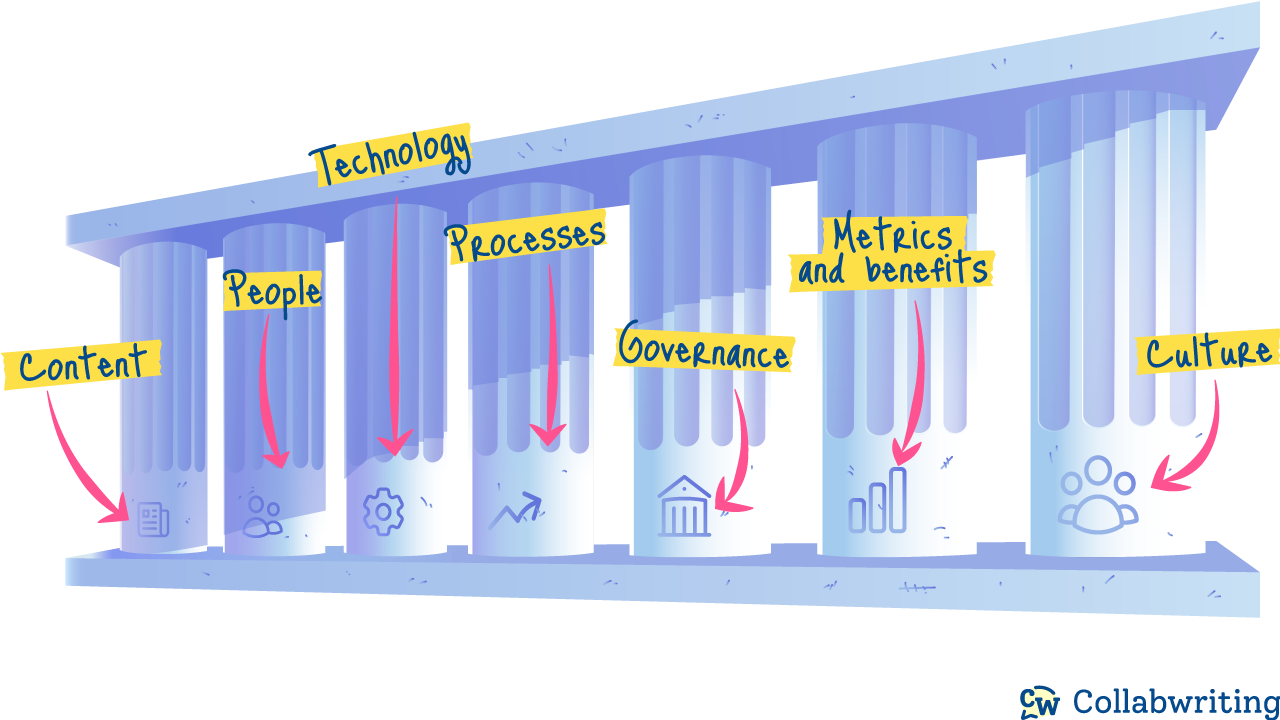
The importance of knowledge sharing in knowledge management
Sharing knowledge is key to making an organization succeed. It helps everyone tap into the collective knowledge, avoid repeating the same work, and solve problems faster.
When people share their knowledge, information becomes available to everyone. This leads to better decisions and improved overall performance.
You can share knowledge in several ways:
- Meetings
- Documentation
- Collaboration tools
And to build a culture where people share knowledge, try these tips:
- Lead by example
- Recognize contributions
- Create incentives
- Provide training
- Build a supportive environment
- Regularly celebrate successes and learnings
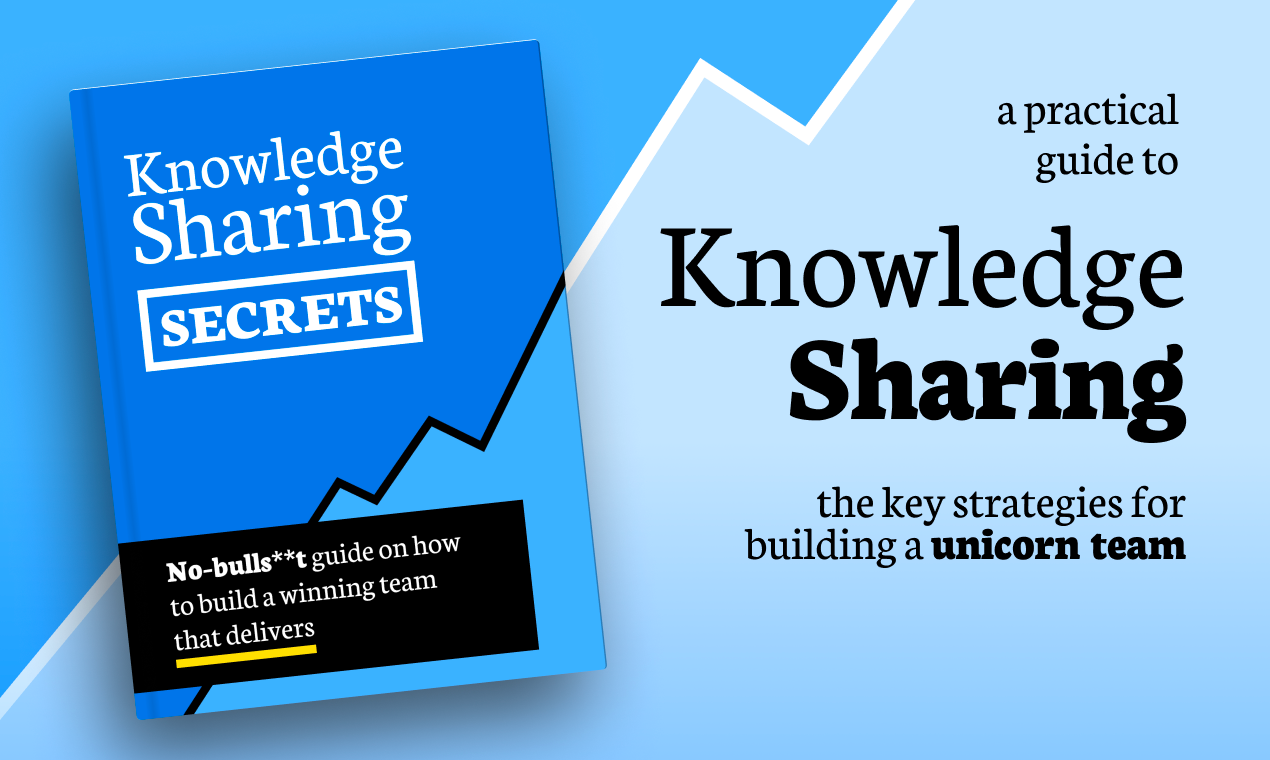
Knowledge Sharing Secrets - Strategies for building Unicorn team
Businesses lose a whopping $31.5 billion each year because they don't share knowledge and resources with their employees, as several studies have found. This effect is even more in small teams where each member plays a crucial role.
Why is it important to have a knowledge base?
A well-organized and comprehensive internal knowledge base is crucial for any organization.
By centralizing knowledge, you can eliminate redundancies, decrease reliance on tribal knowledge, and foster better collaboration among team members.
Whether it's onboarding new employees, resolving common issues, or ensuring consistent communication across departments, a knowledge base promotes efficiency and empowers your workforce.
Types of knowledge base systems
There are 5 primary categories of knowledge bases, which are as follows:
- Internal knowledge base - Used by employees within a company to share information, policies, and procedures
- Hosted knowledge base - An online platform managed by another company to store and access information
- Self-hosted knowledge base - Stored on your own servers, giving you complete control over the data and setup
- Customer service knowledge base - Helps customers find answers to common questions and solve problems on their own
- Open-source knowledge base software - Free software you can use and customize to create your own knowledge base
Depending on what you need the knowledge base for, you'll choose the tool that helps you build it best.
What to put in your knowledge base?
Company information: Annual reports, organizational charts, and contact lists.
Training material: Onboarding materials, employee training plans and templates, health and safety training, and certification training.
Best practices: Including best practices in your internal knowledge base is essential for promoting efficiency and productivity within your organization. These best practices can cover a wide range of topics, such as project management, communication, customer service, and more. By sharing proven strategies and techniques, employees can learn from each other's experiences and adopt successful approaches to their work.
Sales collateral: Case studies, sell sheets, sales process information, and the latest sales numbers.
HR material: Employee handbooks, payslips, and employee review forms.
Documentation: Process documentation, software documentation, standard operating procedures, and checklists.
Marketing collateral: Editorial calendars, social media post templates, and copywriting guidelines.
Media and press kit: Press releases, contact lists, and press images.
Design files: Design guidelines, branding handbook, and color codes.
Legal documents: Contracts, release forms, policies, and regulatory documents.
What’s knowledge hoarding and why is it harmful?
Knowledge hoarding happens when people keep helpful information to themselves instead of sharing it.
Sometimes, individuals gather knowledge just for their own benefit, not realizing how useful it could be to others.
When knowledge is hoarded, productivity suffers, duplicate work increases, and different teams can become misaligned.
On the flip side, a culture of knowledge sharing helps everyone see the bigger picture, collaborate more effectively, and build strong relationships. This not only improves the employee experience but also leads to better customer satisfaction.
Negative outcomes of knowledge hoarding
Employees who hoard information are not helping the business or organization. Knowledge hoarding holds back corporate growth in many ways:
- When teams or individuals hoard knowledge, they create information silos, which slow down efficiency. Employees without necessary knowledge may spend a lot of time searching for it or recreating it which is time-consuming.
- Without a structured knowledge management system in place, you run the risk of losing valuable expertise or explicit knowledge when an employee departs.
- Employees who face difficulties in their work due to knowledge gaps may feel frustrated and choose to quit their jobs.
- It will make it harder for new talent to get up to speed, and new employees may find it challenging to settle into their roles.
How to stop knowledge hoarding?
If knowledge hoarding is causing problems in your organization, you're probably eager to stop it. But how?
To tackle knowledge hoarding, you need both a good system for managing knowledge and a culture that encourages sharing.
A solid knowledge management system needs four things:
- People
- Processes
- Technology and
- Company culture
People hold the knowledge, processes determine how they share it, and technology supports sharing and accessing that knowledge.
Nowadays, AI-powered technology can make your knowledge management system much more effective. It can gather information from various sources to offer a more accessible and relevant knowledge-sharing experience.
Even with the best technology, processes, and team members, you won't succeed without a culture that promotes knowledge sharing.
🔍 Analyze how information is currently shared
🥅 Set clear, measurable goals
🫂 Create a culture that rewards collaboration
💻 Choose the best tools for your needs
📜 Assemble a dedicated knowledge management team
⏰ Schedule regular reviews and updates
💡 Keep up with the latest advancements
How to choose the best knowledge base tool?
Investing in new software can be risky, even with good research. One benefit of a SaaS knowledge base is that there are usually no long-term contracts. You can often try it for free before making a decision.
To boost your chances of success, make sure you understand the knowledge base software industry and know exactly what type of software you need.
Questions to consider about knowledge base software
- Do you need a version control system with strong documentation features for developers?
- Do you need a comprehensive product knowledge base for customer support or internal use?
- What software integrations will you need?
- How much customization do you want?
- How important is the ability to tag, cluster, and organize your notes and research?
- What are your security requirements?
- How many users will be using the software?
- How quickly do you plan to grow your company?
- What documentation format do you prefer?
- Do you want completely free options?
If you answered “yes” to at least four of these questions, it’s a sign that you likely need knowledge-based software.
Remember to write down your answers to all these questions before exploring different options. They will help guide you to the right solution.
Future trends in knowledge management
As we look to the future, technologies like artificial intelligence and machine learning will play a huge role in knowledge management.
These tools can help automatically sort and find large amounts of information, making the process more effective and user-friendly. Adapting to these new technologies is essential for keeping up with the fast-changing information landscape.
They can help organizations retrieve information more accurately, boost efficiency in all departments, and create an environment that encourages innovation.
Technology should support, not replace, human efforts, helping people do their best work.
Conclusion
Knowledge remains an indispensable factor in organizational performance that sets companies apart from their competitors.
We trust that this blog post has provided you with valuable insights into the essence of knowledge management - the "what's" and "whys" - as well as its pivotal role and the best practices to implement it within your organization.
If you're eager to learn more, don't miss out on our free ebook, Knowledge Sharing - Strategies for building a unicorn team.




![The Best Tool for Collaborative Research in Content Marketing Teams [2026]](/content/images/2025/12/image--5-.png)

![5 Tools Marketers Use to Organize Research - Compared [2026]](/content/images/2025/11/cover-4-1.png)

![Build Credibility in Research: Smart Way to Verify Information and Track Sources Easily [2025]](/content/images/2025/10/covers-for-blog--7--1.png)

![How Marketers Can Turn LinkedIn Content into Collaborative Research [2025]](/content/images/2025/10/covers-for-blog--8-.png)
![Best Readwise Alternative for Personal & Team Research [2026]](/content/images/2025/09/Frame-814--3-.png)
